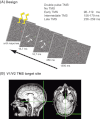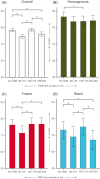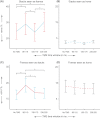Two critical periods in early visual cortex during figure-ground segregation
- PMID: 23170239
- PMCID: PMC3500463
- DOI: 10.1002/brb3.91
Two critical periods in early visual cortex during figure-ground segregation
Abstract
The ability to distinguish a figure from its background is crucial for visual perception. To date, it remains unresolved where and how in the visual system different stages of figure-ground segregation emerge. Neural correlates of figure border detection have consistently been found in early visual cortex (V1/V2). However, areas V1/V2 have also been frequently associated with later stages of figure-ground segregation (such as border ownership or surface segregation). To causally link activity in early visual cortex to different stages of figure-ground segregation, we briefly disrupted activity in areas V1/V2 at various moments in time using transcranial magnetic stimulation (TMS). Prior to stimulation we presented stimuli that made it possible to differentiate between figure border detection and surface segregation. We concurrently recorded electroencephalographic (EEG) signals to examine how neural correlates of figure-ground segregation were affected by TMS. Results show that disruption of V1/V2 in an early time window (96-119 msec) affected detection of figure stimuli and affected neural correlates of figure border detection, border ownership, and surface segregation. TMS applied in a relatively late time window (236-259 msec) selectively deteriorated performance associated with surface segregation. We conclude that areas V1/V2 are not only essential in an early stage of figure-ground segregation when figure borders are detected, but subsequently causally contribute to more sophisticated stages of figure-ground segregation such as surface segregation.
Keywords: EEG; TMS; V1/V2; scene segmentation; visual perception.
Figures







Similar articles
-
Feedforward and recurrent processing in scene segmentation: electroencephalography and functional magnetic resonance imaging.J Cogn Neurosci. 2008 Nov;20(11):2097-109. doi: 10.1162/jocn.2008.20142. J Cogn Neurosci. 2008. PMID: 18416684
-
Figure-ground segregation requires two distinct periods of activity in V1: a transcranial magnetic stimulation study.Neuroreport. 2005 Sep 8;16(13):1483-7. doi: 10.1097/01.wnr.0000175611.26485.c8. Neuroreport. 2005. PMID: 16110276
-
Opposing dorsal/ventral stream dynamics during figure-ground segregation.J Cogn Neurosci. 2014 Feb;26(2):365-79. doi: 10.1162/jocn_a_00497. Epub 2013 Oct 11. J Cogn Neurosci. 2014. PMID: 24116840
-
Dynamic coding of border-ownership in visual cortex.J Vis. 2012 Jan 1;12(13):8. doi: 10.1167/12.13.8. J Vis. 2012. PMID: 23220579 Review.
-
V1 mechanisms and some figure-ground and border effects.J Physiol Paris. 2003 Jul-Nov;97(4-6):503-15. doi: 10.1016/j.jphysparis.2004.01.008. J Physiol Paris. 2003. PMID: 15242660 Review.
Cited by
-
Figure-ground perception in the awake mouse and neuronal activity elicited by figure-ground stimuli in primary visual cortex.Sci Rep. 2018 Dec 12;8(1):17800. doi: 10.1038/s41598-018-36087-8. Sci Rep. 2018. PMID: 30542060 Free PMC article.
-
Perceptual Gains and Losses in Synesthesia and Schizophrenia.Schizophr Bull. 2021 Apr 29;47(3):722-730. doi: 10.1093/schbul/sbaa162. Schizophr Bull. 2021. PMID: 33150444 Free PMC article.
-
NMDA receptor antagonist ketamine impairs feature integration in visual perception.PLoS One. 2013 Nov 1;8(11):e79326. doi: 10.1371/journal.pone.0079326. eCollection 2013. PLoS One. 2013. PMID: 24223927 Free PMC article. Clinical Trial.
-
Scene complexity modulates degree of feedback activity during object detection in natural scenes.PLoS Comput Biol. 2018 Dec 31;14(12):e1006690. doi: 10.1371/journal.pcbi.1006690. eCollection 2018 Dec. PLoS Comput Biol. 2018. PMID: 30596644 Free PMC article.
-
The essential role of recurrent processing for figure-ground perception in mice.Sci Adv. 2021 Jun 30;7(27):eabe1833. doi: 10.1126/sciadv.abe1833. Print 2021 Jun. Sci Adv. 2021. PMID: 34193411 Free PMC article.
References
-
- Albright TD, Stoner GR. Contextual influences on visual processing. Annu. Rev. Neurosci. 2002;25:339–379. - PubMed
-
- Bach M, Meigen T. Similar electrophysiological correlates of texture segregation induced by luminance, orientation, motion and stereo. Vision Res. 1997;37:1409–1414. - PubMed
-
- Benjamini Y, Hochberg Y. Controlling the false discovery rate: a practical and powerful approach to multiple testing. J. Roy. Stat. Soc. B (Methodol.) 1995;57:289–300.
LinkOut - more resources
Full Text Sources

